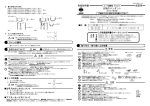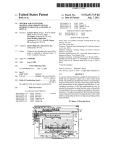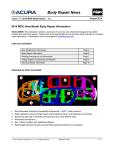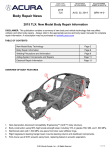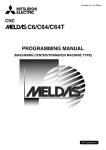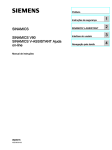Download MSD Servo Drive TWINsync Module
Transcript
moog MSD Servo Drive Description of remark TWINsync module moog MSD Description of remark TWINsync module L2 L3 L1 NOTE: This document does not replace the MSD Servo Drive Operation Manual. Please be sure to observe the information contained in the “For your safety”, “Intended use” and “Responsibility” sections of the Operation Manual (ID no.: CA65642-001). For information on installation, setup and commissioning, and details of the warranted technical characteristics of the MSD Servo Drive series, refer to the additional documentation (Operation Manual, User Manual, etc.). x 11 + - + - + - - + x 8 x 10 x 9 x x 7 6 Description of remark TWINsync module Interface X 8 ID no.: CB08759-001, Rev. 1.0 Date: 10/2010 Applicable as from firmware version: V2.15 / V201.07 Technical alterations reserved. The contents of our documentation have been compiled with greatest care and in compliance with our present status of information. Nevertheless we would like to point out that this document cannot always be updated parallel to the technical further development of our products. Information and specifications may be changed at any time. For information on the latest version please refer to [email protected]. Table of contents 5.3 TWINpos mode........................................................................................................14 5.3.1 TWINpos Master mode.................................................................................14 5.3.2 TWINpos Slave mode...................................................................................14 1. 2. TWINsync technology option.................................................... 4 1.1 Hardware requirements...........................................................................................4 1.2 Software requirements............................................................................................4 6.Monitoring functions / Error messages.................................... 16 Installation................................................................................ 5 2.1Pin assignment of the TWINsync connecting cable..................................................5 3. Parameter description............................................................... 6 3.1General parameters of the TWINsync communication interface...............................6 3.1.1 Master/Slave selector (P 2614)...........................................................................7 3.1.2 Communication timeout monitoring............................................................7 3.1.3 Structure of the TWINsync data telegram.....................................................7 3.1.4 Configuration of the process data................................................................8 3.1.5 Scaling of process data.................................................................................8 3.1.6 Boot-up delay...............................................................................................9 3.2 Parameterization of the TWINsync master axis.........................................................9 3.3 Parameterization of the TWINsync slave axis............................................................10 4. Open-loop control via TWINsync..............................................11 5. TWINsync operation modes.................................................... 12 5.1 USER mode..............................................................................................................12 5.2 TWINspeed mode....................................................................................................12 5.2.1 TWINspeed Master.......................................................................................12 5.2.2 TWINspeed Slave Mode 1.............................................................................13 5.2.3 TWINspeed Slave Mode 2.............................................................................13 moog MSD Description of remark TWINsync module 3 [ TWINsync module ] moog 1. TWINsync technology option MSD Description of remark TWINsync module 4 Key features of the TWINsync option: –– Serial data transfer via twisted-pair cable (RS485) in master/slave mode –– Electrical isolation of the transfer channel from the control board This document describes the TWINsync technology option for the MSD Servo Drive. The TWINsync technology option is based on an optional communication interface available for the MSD Servo Drive for option slot 2 via which two MSD Servo Drive devices can be interconnected at a time. Consequently, use of the TWINsync option is intended for applications in which, for example, synchronism of two drives is specified or in which one drive is to use I/O or encoder interfaces of another drive. –– Transfer rate: 4 MBaud Using the TWINsync option, any process data can be exchanged between two drives. The data are exchanged bidirectionally with the cycle time of the speed control. –– Monitored synchronization of master and slave at PWM level The TWINsync communication interface incorporates a synchronization mechanism. The MSD Servo Drive configured as the TWINsync master generates a cyclic signal pulse synchronized to its own control cycle on the SYNC OUT line of the interface. The MSD Servo Drive configured as the TWINsync slave receives the synchronization signal on its SYNC IN line and synchronizes its own control cycle to the TWINsync master. ! ATTENTION: Because of the synchronization mechanism, the EtherCAT and SERCOS II field bus options are currently not supported in "TWINsync slave" mode, as they have their own synchronization mechanisms. Configuration parameters can be set to define the process data to be exchanged via the TWINsync interface. The parameters from which the data to be sent are compiled, and the parameters to which the received data are copied, are set both for the TWINsync master and the TWINsync slave. By way of the TWINsync interface a maximum of three parameters with a maximum total 8 bytes' length can be cyclically exchanged in both directions. The following listing summarizes the key features of the TWINsync option. –– Full-duplex mode –– Frame size: 12 bytes, of which 8 bytes user data in each transfer direction –– Frame rate: Data transfer takes place at the speed control clock rate (depending on the switching frequency, 8 kHz maximum) –– Free mapping of the sent and received data onto parameters –– Monitoring of data transfer with a 16-bit CRC checksum 1.1 Hardware requirements For TWINsync linking of two MSD Servo Drive drives the TWINsync option board for the X8 technology interface of the MSD Servo Drive is required in both drives (article no.: G39x-xxx-x4x-xxx). The TWINsync option board is factory-fitted and automatically detected by the MSD Servo Drive firmware (monitored via display parameter P 0053 = TWINsync (2)). 1.2 Software requirements Firmware version V2.15 / V201.07 is required to run the TWINsync option. 2. Installation ! ATTENTION: Please be sure to read the MSD Servo Drive Operation Manual before installing the device. It contains essential information relating to safety and installation as well as detailed connection diagrams. The TWINsync connecting cable must be shielded. The pin assignment of the D-Sub male connectors on the cable ends is set out in table 2.2. When using a twisted-pair connecting cable, the pairs must be formed from the respective matching terminals (+ and -). The signal pairs of SYNC IN and SYNC OUT and of RX and TX must be crossed over in the cable. The SYNC IN on one connector end is connected to the SYNC OUT on the other end and vice versa. The same applies to RX and TX. The '+' cable of one signal must be connected to the respective '+' cable of the other. The respective '-' cables must be interconnected in the same way. Connector 1 Cable Connector 2 Pin no. 2.1 P in assignment of the TWINsync connecting cable The TWINsync option board is located on option slot 2 of the MSD Servo Drive (see Operation Manual) and has a 9-pin D-Sub female connector (X8). The connector pin assignment is set out in table 2.1. Pin Option board X8 signal Meaning 1 SYNC IN- Synchronization interrupt in via RS485 converter 2 SYNC OUT- 3 GND GND from driver 4 RX+ UART via RS485 converter Receive + 5 TX+ UART via RS485 converter Transmit + Synchronization interrupt out via RS485 converter 6 SYNC IN+ 7 SYNC OUT+ 8 RX- UART via RS485 converter Receive - 9 TX- UART via RS485 converter Transmit - Table 2.1 Table 2.2 Pin no. 1 SYNC IN- SYNC OUT- 2 2 SYNC OUT- SYNC IN- 1 3 GND GND 3 4 RX+ TX+ 5 5 TX+ RX+ 4 6 SYNC IN+ SYNC OUT+ 7 7 SYNC OUT+ SYNC IN+ 6 8 RX- TX- 9 9 TX- RX- 8 Pin assignment of the TWINsync connecting cable Synchronization interrupt in via RS485 converter Synchronization interrupt out via RS485 converter Assignment of the 9-pin D-Sub female connector X8 on the TWINsync option board moog MSD Description of remark TWINsync module 5 [ TWINsync module ] moog MSD Description of remark TWINsync module 3. Parameter description ID SubID P 2616 0 The following details the specific parameters of the TWINsync option board. NOTE: For a description of general parameters refer to the MSD Servo Drive user documentation. 3.1 G eneral parameters of the TWINsync communication interface Table 3.1 shows the configuration parameters for the communication interface of the TWINsync option. ID SubID P 2613 0 P 2614 0 Name TOPT_MASLV_MaxFaultTime TOPT_MASLV_Mode Unit ms Description Float32 Select Master or Slave Mode UInt16 1 = SLAVE Table 3.1 TOPT_MASLV_ProcessSendData TOPT mapping of process data to be send UInt16 0 TOPT_MASLV_ProcessSendData number of mapped process data objects to be send UInt32 1 TOPT_MASLV_ProcessSendData 1. mapped process data UInt32 2 TOPT_MASLV_ProcessSendData 2. mapped process data UInt32 3 TOPT_MASLV_ProcessSendData 3. mapped process data UInt32 Configuration parameters of the TWINsync technology option board TOPT mapping of process data to be send TOPT_MASLV_ProcessReceiveData number of mapped process data objects to be recieved Data type UInt32 1 TOPT_MASLV_ProcessReceiveData 1. mapped process data UInt32 TOPT_MASLV_ProcessReceiveData 2. mapped process data UInt32 3 TOPT_MASLV_ProcessReceiveData 3. mapped process data UInt32 P 2617 0 TOPT_MASLV_Statusword recieved system statusword UInt16 P 2618 0 TOPT_MASLV_BootDelay Increase boot-time to allow synchronisation UInt16 Status of communication UInt16 P 2619 TOPT_MASLV_CommStatus ms 0 = No error 1 = Communication Error 2 = switching-frequency discrepancy 3 = mode conflict 4 = remote error P 2651 TOPT_MASLV_SlaveErrCtrl Activates the current slave error monitoring UInt8 P 2583 TOPT_MASLV_SlaveInvert Invert slave motion direction Int8 Table 3.1 2 = MASTER Description TOPT_MASLV_ProcessReceiveData Data type Maximum fault state time for TOPT communication channel Unit 2 0 = OFF P 2615 Name 6 Configuration parameters of the TWINsync technology option board 3.1.1 Master/Slave selector (P 2614) 3.1.2 Communication timeout monitoring By way of the TWINsync interface the TWINsync slave synchronizes to the TWINsync master. Consequently, one of the two drives must be configured as the TWINsync master and one as the TWINsync slave. Parameter P 2614 is use to specify the Master/Slave mode. ID Selection text Value P 2614 OFF 0 Selecting OFF disables the TWINsync interface. In the OFF state no process data are sent and no SYNC OUT signal is generated. SLAVE 1 Selecting SLAVE switches the MSD Servo Drive to TWINsync Slave mode. The slave drive synchronizes its control cycle to the incoming SYNC IN signals. If the SYNC IN signal is not received for a parameterizable time, a communication error is reported (see section 3.1.2 ) MASTER Table 3.2 ! 2 Description Selecting MASTER switches the MSD Servo Drive to TWINsync Master mode. SYNC OUT signals are generated for the slave. P 2614 setting options ATTENTION: For synchronization it is essential that both drives are configured to the same switching frequency, as it is used for synchronization. Consequently, parameter P 0302 must be set to the same value for both axes. moog A disturbance on the communication interface is detected as follows: –– The MSD Servo Drive receives invalid data (CRC monitoring). –– The synchronization signal of the TWINsync master drops out. If one of these errors occurs, the transfer channel is assumed to be disturbed. Parameter P 2613 defines the time interval (in ms) over which the channel may be classed as disturbed without an error being reported. In the event of a disturbance the last correctly received data are frozen. The error messages are documented in section 6. 3.1.3 Structure of the TWINsync data telegram The TWINsync data telegram is structured as shown in table 3.3. It comprises 3x2 bytes of fixed data (16 bits CRC, 16 bits TWINsync status word and one control/status word to change the slave device state) and 6 bytes of freely configurable data. Checksum (fixed) TWINsync Status word (fixed) 2 bytes Table 3.3 2 bytes Control/ status word (DRIVECOM) (fixed) 2 bytes PDO1 PDO2 PDO3 (configurable) (configurable) (configurable) 6 bytes TWINsync data telegram MSD Description of remark TWINsync module 7 [ TWINsync module ] moog MSD Description of remark TWINsync module The checksum is formed in each case across the entire telegram. The assignment of the TWINsync status word is shown in table 3.4. Bit no. Function 0 ProcessDataMode Description 0 = initialization mode Bit no. 2 bytes parameter ID of the parameter to be sent as HEX value xxxxSSxxh 1 byte parameter sub-ID of the parameter to be sent as HEX value SwitchingFrequency 010 = 6 kHz 011 = 8 kHz 100 = 12 kHz 101 = 16 kHz 4-6 TWINMode 16-bit parameters (Int16,UInt16): WW = 10h. 000 = 2 kHz 001 = 4 kHz 0 = TWINsync off 1 bytes word width of the parameter to be sent as HEX value 32-bit parameters (Int32,UInt32, Float32): WW = 20h. 1 = cyclic mode 1-3 Description PPPPxxxxh xxxxxxWWh 8 Table 3.5 S tructure of parameter P 2615 / P 2615 (sub-ID: 1-3) for mapping of the process data to be sent A fundamental requirement when configuring the process data is that the sequence and data width of the received data of one axis matches the sequence and data width of the sent data of the other axis. This parameter matching cannot be monitored by the MSD Servo Drive and so must be ensured by the user. 1 = TWINsync slave 2 = TWINsync master 7 SlaveInSync 0 = slave is synchronized 1 = slave is not synchronized 8-13 not_used 14 SystemError Drive in "error" state 15 TechOptError Communication error occurred Table 3.4 Reserved Assignment of the TWINsync status word (parameter P 2617) 3.1.4 Configuration of the process data The process data to be sent and received by the drive can be configured by parameters. For manual configuration, parameters P 2615 (mapping of sent data) and P 2616 (mapping of received data) can be modified directly. The mode selector (parameter P 2580) can also be used to set an automatic configuration for preset operation modes (see section 5). P 2615 and P 2616 are field parameters with four elements each. The first element (sub-ID: 0) determines how many parameters are sent/received by this axis. A maximum of three parameters are supported in each direction. The other three field elements (sub-ID:1-3) select which parameters are sent/received. The entries under sub-ID 1-3 are coded as set out in table 3.5. 3.1.5 Scaling of process data In order to transfer the three most frequently used variables – torque, speed and position – via the TWINsync interface simultaneously, appropriate conversion of torque and speed variables from the internally used 4-byte floating-point format into a scaled 2-byte integer format is implemented. The reference variables for scaling of the "local" torque and speed values (sent data) are preset via parameter P 2602. The reference variables for de-scaling of the ("remote") torque and speed values received from the external drive are preset via parameter P 2609 (see table 3.6). The first field entry (sub-ID:0) of P 2602 / P 2609 contains the value of the reference torque in Nm. The second field entry (sub-ID:1) contains the value of the reference speed in rpm. The scaling maps the value range between the negative and positive reference values to the number range [-32768 to 32767]. The position data are transferred in the format specified by the unit parameter setting of the device (Factor Group) as 32-bit integer. NOTE: Generally, the reference variables P 2602 / P 2609 and the factor group settings should be identical in the master and slave drives. ID SubID Name P 2602 Unit Description Data type MPRO_TWIN_LocalScaling 0 MPRO_TWIN_LocalScalingTorque Nm Local drive reference torque Float32 1 MPRO_TWIN_LocalScalingSpeed rpm Local drive reference speed Float32 P 2609 ID SubID Name Unit P 2603 0 MPRO_TWIN_RemoteRefTorque Scaled Scaled torque reference (remote) Int16 P 2604 0 MPRO_TWIN_RemoteActTorque Scaled Scaled actual torque (remote) Int16 P 2605 0 MPRO_TWIN_RemoteRefSpeed Scaled Scaled speed reference (remote) Int16 P 2606 0 MPRO_TWIN_RemoteActSpeed Scaled Scaled actual speed (remote) Int16 P 2607 0 MPRO_TWIN_RemoteRefPos POS Position reference (remote) Int32 P 2608 0 MPRO_TWIN_RemoteActPos POS Actual position (remote) Int32 MPRO_TWIN_RemoteScaling 0 MPRO_TWIN_RemoteScalingTorque Nm External drive reference torque Float32 1 MPRO_TWIN_RemoteScalingSpeed rpm External drive reference speed Float32 Table 3.6 Reference variables for scaling of the local and external torque and speed signals Table 3.7 shows the parameters typically used for the process data being sent. Parameters P 2596 to P 2601 describe the "local" target and actual values for torque, speed and position. ID SubID P 2596 0 MPRO_TWIN_LocalRefTorque Scaled Scaled torque reference (local) Int16 P 2597 0 MPRO_TWIN_LocalActTorque Scaled Scaled actual torque (local) Int16 P 2598 0 MPRO_TWIN_LocalRefSpeed Scaled Scaled speed reference (local) Int16 P 2599 0 MPRO_TWIN_LocalActSpeed Scaled Scaled actual speed (local) Int16 P 2600 0 MPRO_TWIN_LocalRefPos POS Position reference (local) Int32 P 2601 0 MPRO_TWIN_LocalActPos POS Actual position (local) Int32 Table 3.7 Name Unit Description Data type Parameters frequently used to send process data Table 3.8 shows the parameters typically used for the process data being received. Parameters P 2603 to P 2608 are available as data containers to receive the external ("Remote") target and actual values for torque, speed and position. moog Table 3.8 Description Data type Parameters frequently used to receive process data The scaled parameters for speed and torque provided on the send end also exist on the receive end. The torque and speed information required for de-scaling is entered in parameter P 2609. As a result the received 16-bit integer is converted back to the local units system. 3.1.6 Boot-up delay The synchronization between the master and slave axes takes a certain amount of time after booting up. If one or both of the controllers in the TWINsync pairing is set to control mode without a delay after connection of the power, it may be that a communication error is reported because no synchronization has yet taken place. This can be prevented by using parameter P 2618 (see table 3.1) to extend the boot-up initialization phase of the MSD Servo Drive by a programmable time so that the synchronization is completed during initialization. 3.2 Parameterization of the TWINsync master axis The master axis receives reference (setpoint) values according to the parameterized reference source (e.g. from a field bus). Apart from configuration of the send data, the master axis requires no further special parameter setting. Slave process data can also be received however. MSD Description of remark TWINsync module 9 [ TWINsync module ] moog 3.3 Parameterization of the TWINsync slave axis The slave axis receives the reference (setpoint) values from the master axis and uses them dependent on the TWINsync mode preset via parameter P 2580. Depending on the mode, master axis torque, speed or position reference or actual values are required. For the slave axis to receive the reference value via the TWINsync interface, the setpoint source must be configured via parameter P 0165 ("MPRO_REF_SEL") to the value 11=TWINsync. The reference values for control of the slave axis are then formed from the parameters listed in table 3.8 dependent on the control mode set by the control mode selector (P 0300). The scaled parameters are first scaled back to the local units system in line with field parameter P 2609. MSD Description of remark TWINsync module 10 4. Open-loop control via TWINsync The slave drive in the TWINsync pairing can be controlled by the TWINsync master by way of the TWINsync control word or any other control location (e.g. digital inputs or field bus). The control location is configured using the control location selector (parameter: P 0159). To select the control location "TWINsync", the value "TWINsync (8)" must be set for P 0159. Open-loop control of the drive is then effected by way of the TWINsync control word (parameter P 2611, see table 4.1 ) and the drive status is mapped in parameter P 2612 (see table 4.2 ). The TWINsync master copies its own control word to the TWINsync control word transferred over the process data channel from the TWINsync master to the TWINsync slave. The TWINsync slave thus obeys the same control commands as the TWINsync master. Error resets and homing can additionally be initiated on the slave by way of the TWINsync control word. The TWINsync slave likewise transfers its TWINsync status word back to the TWINsync master via the process data channel. Bit no. Function Description Reserved Bit no. Function Description 14 FREE3 Reserved 15 FREE4 Reserved Table 4.1 Assignment of the TWINsync control word (parameter P 2611) Bit no. Function Description 0 Operation_mode_0 1 Operation_mode_1 2 Operation_mode_2 3 Operation_mode_3 4 Operation_mode_4 Reserved 5 OperationEnabled Loop control active 6 Fault Drive in fault (error) state 7 CoastStop Drive is torque-free 8 QuickStop Drive in "quick-stop" state 9 Homing attained Drive is homed 0 Operation_mode_0 10 FREE1 1 Operation_mode_1 11 FREE2 2 Operation_mode_2 12 FREE3 3 Operation_mode_3 13 ActDrivecom_0 Current DriveCom state bit 0 4 Operation_mode_4 14 ActDrivecom_1 Current DriveCom state bit 1 5 EnableOperation Start loop control 15 ActDrivecom_2 Current DriveCom state bit 2 6 SwitchOn Switch on power stage 7 CoastStop Drive torque-free 8 QuickStop Quick stop 9 StartHoming Start homing 10 FaultReset Fault (error) reset 11 EnableVoltage # 12 FREE1 Reserved 13 FREE2 Reserved Table 4.1 Table 4.2 Reserved Assignment of the TWINsync control word (parameter P 2612) Assignment of the TWINsync control word (parameter P 2611) moog MSD Description of remark TWINsync module 11 [ TWINsync module ] moog 5. TWINsync operation modes By way of parameter P 2580 various preset TWINsync operation modes can be selected. The process data configuration is automatically effected according to the selected mode. In the following the selectable operation modes are listed. MSD Description of remark TWINsync module 5.2 TWINspeed mode TWINspeed mode is useful for speed synchronization of mechanically coupled axes, such as twin traction or lift drives. The master transfers its actual speed and torque values via the TWINsync interface to the TWINsync slave. The TWINsync slave then processes the two variables and forwards them to an internal closed-loop control structure. Figure 5.1 shows the process data interface between the master and slave drives in TWINspeed mode. 5.1 USER mode If this mode is selected the user can assign the process data channel of the TWINsync bus freely. For this, field parameters "TOPT_TWIN_ProcessSendData" (P 2615) and "TOPT_TWIN_ProcessReceiveData" (P 2616) can be used to define how many, and which, objects are to be sent or received (see section 3.1.4). If the mapping (parameter TOPT_TWIN_ProcessSendData (P 2615) / TOPT_TWIN_RecieveData (P 2616)) is changed by the user, the mode is automatically reset to USER. 12 Fixed mapping Control word P2611 Communication status P2617 Checksum Status word P2612 Communication status P2617 Checksum MSD Servo Drive Master Mapping by mode TWINSPD MSD Servo Drive Slave Actual torque P2597 Actual speed P2599 Error number P2650[0] Error location P2650[1] Figure 5.1 TWINspeed process data interface 5.2.1 TWINspeed Master This mode is selected by setting P 2580 = "TWINSPD_Master". In this mode the master transmits its actual torque (P 2597) and actual speed (P 2599) values. The received data expected by the master via TWINsync are interpreted as the current error number (P 2650[0]) and error location (P 2650[1]) of the slave drive. 5.2.2TWINspeed Slave Mode 1 ID In this mode the actual speed value of the master drive is used as the primary speed reference (primary setpoint) of the slave drive. A secondary reference proportional to the primary reference is added to the primary reference and specified as a percentage by way of parameter P 2584. If the secondary reference calculated in this way falls below the threshold value set by parameter (P 2585), that threshold value is used as the secondary reference. In this, the sign of the secondary reference corresponds to the sign of the actual torque value of the master drive. Figure 5.2 shows the closed-loop control structure of the slave drive. Master actual torque P2597 P2609[0] 32768 P2584 Master actual speed P2599 P2609[1] 32768 Setting in master Setting in slave MASTER (2) SLAVE (1) TWIN_Setting TWINSPD_MASTER1 (1) TWINSPD_SLAVE1 (2) Control mode Any SCON(2) P 0165 Reference selector Any TWINsync (11) P 0301 Reference mode P 2615 Mapping of send data TWINdrive mode P 2580 P 0300 P2581 P2585 x SIGN() MAX() x Slave torque setpoint P2582 P 2616 Filter – Speed controller Slave actual speed Parameter P 2614 Torque setpoint Torque setpoint filter limitation Any moog Table 5.1 Meaning Parameter value Meaning Sub-ID 0 0x0000 0002 2 objects 0x0000 0002 2 objects Sub-ID 1 0x0A25 0010 Actual torque P 2597[0] (16 bits) 0x0A5A 0010 Current error number P 2650[0] (16 bits) Sub-ID 2 0x0A27 0010 Actual speed P 2599[0] (16 bits) 0x0A5A 0110 Current error location P 2650[1] (16 bits) Parameter value Meaning Parameter value Meaning Mapping of receive data Sub-ID 0 0x0000 0002 2 objects 0x0000 0002 2 objects Sub-ID 1 0x0A5A 0010 Current error number P 2650[0] (16 bits) 0x0A2C 0010 RemoteActTorque P 2604[0] Sub-ID 2 0x0A5A 0110 Current error location P 2650[1] (16 bits) 0x0A2E 0010 RemoteActSpeed P 2606[0] Figure 5.2 Closed-loop control structure, TWINspeed Slave Mode 1 The actual torque value of the master determines the torque reference limitation in the slave drive. Accordingly, during a positioning job the torque limitation of the slave is adapted online to the actual torque value of the master. The torque is thus split optimally across both drives and pass-through of the slave drive is prevented in the event of short-time cutting of the mechanical coupling, such as when mechanical slip occurs in a traction drive. IP mode (1) Parameter value P arameters on master and slave drive for the preset TWINsync mode TWINspeed Mode 1 5.2.3TWINspeed Slave Mode 2 This mode is a further variant for synchronization of mechanically coupled drive axes. The master transfers its current actual speed and torque values via the TWINsync interface to the slave. The slave uses the current master actual torque value as a torque pre-control signal on the speed controller output. The received actual speed value of the master is used as the speed reference for the slave's speed control loop. Optionally, the actual speed value can be filtered via a PT-1 element. The speed controller on the slave side should be configured as a weak P-controller in this mode. MSD Description of remark TWINsync module 13 [ TWINsync module ] moog Mapping of the process data channel on the master and slave sides is the same as in TWINspeed Mode 1 (see table 5.1). 5.3 TWINpos mode This mode is useful for position synchronization between a master and slave drive. An electronic gear unit can additional be used on the slave axis. Figure 5.3 shows the process data interface between the master and slave drives in TWINpos mode. 5.3.2TWINpos Slave mode In this mode the actual position value of the master drive (P 2608) is used for positioning reference generation and the current actual speed value (P 2606) for external speed precontrol generation. Figure 5.4 shows the logical sequencing. P270 Slave internal resolution [incr/rev] P2652 Master_internal resolution [incr/rev] 1/P2657 MPRO_TWIN_StrechFactor Master actual position (k-1) [incr] P2608 Master actual position (k) [incr] - Fixed mapping ∆ Position [incr] x P2583 Position setpoint SlaveModuloValue [Userunits] [incr] ∆ Position_corr [incr] Control word P2611 Communication status P2617 Checksum MSD Servo Drive Master 14 MSD Description of remark TWINsync module x POS 2 USER x x Status word P2612 Communication status P2617 Checksum Mapping by mode TWINPOS + MSD Servo Drive Slave Actual position P412 Actual speed P2599 Analog input xx [-1 ... 1] P2583 Slave inversion [-1/1] Correction_factor_ Nref_FF P2606 Master actual speed [U/min] x + x x x Speed pre-control value [Userunits] 1/P2657 MPRO_TWIN_StrechFactor Figure 5.3 TWINpos process data interface Correction factor Nref FF = This mode is selected by setting P 2580 = "TWINPOS_Master". In this mode the master transmits its actual position (P 0412) and speed (P 2599) values. The received data are interpreted as the current error number (P 2650[0]) and error location (P 2650[1]) of the slave drive. x P2655 Correction factor Error number P2650[0] Error location P2650[1] 5.3.1 TWINpos Master mode P2653 MPRO_TWIN_ ElecGearNum P2654 MPRO_TWIN_ ElecGearDen Slave internal resolution [Userunits/rev] * IpRefTS [ms] 60000 [min * s/min * s/ms] Figure 5.4 TWINpos Slave closed-loop control structure Delta increments per scan step are formed from the incremental master actual position P 2608. If the resolution factors vary between the master and slave, the delta increments are corrected by the factor P 0270 / P 2652. Then the corrected delta increments are multiplied firstly by the transmission ratio of the electronic gearing (P 2653 / P 2654) and secondly by the analog correction factor and the results are added together. In addition, parameter P 2583 can be used to execute a reversal of rotation direction between the master and slave. Then the corrected delta increments are up-integrated to the incremental modulo value of the slave. For external speed pre-control, the current actual speed value of the master is used in revolutions per minute. Just as in position process- ing, this actual value is multiplied by the factor of the electronic gearing (P 0270 / P 2652) and by the same analog correction factor. ID Parameter P 2614 TWINdrive mode P 2580 Setting in master Setting in slave MASTER (2) SLAVE (1) TWIN_Setting TWINPOS_MASTER (7) TWINPOS_SLAVE (8) P 0300 Control mode Any PCON(2) P 0165 Reference selector Any TWINsync (11) P 0301 Reference mode Any IP mode (1) P 2615 Mapping of send data P 2616 Table 5.2 Parameter value Meaning Parameter value Meaning Sub-ID 0 0x0000 0002 2 objects 0x0000 0002 2 objects Sub-ID 1 0x019C 0010 Actual position P 0412 (32 bits) 0x0A5A 0010 Current error number P 2650[0] (16 bits) Sub-ID 2 0x0A27 0010 Actual speed P 2599[0] (16 bits) 0x0A5A 0110 Current error location P 2650[1] (16 bits) Parameter value Meaning Parameter value Meaning Mapping of receive data Sub-ID 0 0x0000 0002 2 objects 0x0000 0002 2 objects Sub-ID 1 0x0A5A 0010 Current error number P 2650[0] (16 bits) 0x0A30 0020 RemoteActPos P 2608[0] Sub-ID 2 0x0A5A 0110 Current error location P 2650[1] (16 bits) 0x0A2D 0010 RemoteRefSpeed P 2605[0] Parameters on master and slave drive for the preset TWINsync mode TWINpos moog MSD Description of remark TWINsync module 15 [ TWINsync module ] moog MSD Description of remark TWINsync module 6. M onitoring functions / Error messages The data transfer of the master/slave link is continuously monitored. Errors can occur either when a parameter is incorrectly set or if there is a disturbance on the transfer channel. Errors are only reported when the MSD Servo Drive is in closed-loop control mode (display shows state 5). The master/slave link has the primary error group (error number) 46. A list of possible errors is set out in table 6.1. Error ID 46 00 Error cause Remedy Faulty data transfer. This can occur when there has been disturbance on the channel for a time longer than that configurable via P 02613. The error is also reported if the slave has lost the synchronization. Check connector. Check cable. Check MSD Servo Drive. 46 01 Master and slave have different switching frequency parameter settings. Correct parameter setting. 46 02 Both axes are parameterized either as master or as slave. Correct parameter setting. Table 6.1 Error messages in master/slave operation 16 TAKE A CLOSER LOOK. Moog solutions are only a click away. Visit our worldwide Web site for more information and the Moog facility nearest you. moog Moog GmbH Hanns-Klemm-Straße 28 D-71034 Böblingen Telefon +49 7031 622 0 Telefax +49 7031 622 100 www.moog.com/industrial [email protected] Moog is a registered trademark of Moog, Inc. and its subsidiaries. All quoted trademarks are property of Moog, Inc. and its subsidiaries. All rights reserved. © 2010 Moog GmbH Technical alterations reserved. The contents of our documentation have been compiled with greatest care and in compliance with our present status of information. Nevertheless we would like to point that this document cannot always be updated parallel to the technical further development of our products. Information and specifications may be changed at any time. For information on the latest version please refer to [email protected]. ID no: CB08759-001 Rev. 1.0, 10/2010

















